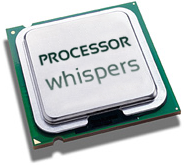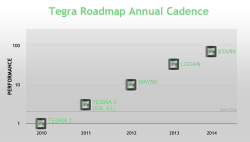Processor Whispers: About Bugs, Bidders and Batmen
 by Andreas Stiller
by Andreas Stiller
The new year begins like the old year ends: Delays with Windows tablets, bugs in hardware and software and glimpses of new – naturally much better – chips, like NVIDIA's Wayne.
Dell and HP had to pass on the Christmas business with their Windows 8 tablets. Rumors again blame Microsoft for the delay, whose Quality Testing Lab supposedly takes too much time for testing and might find little faults all over the place. And so, the Intel Atom Z2760-equipped Dell Latitude 10 and HP Envy x2 11t-g000 won't arrive before the start of the new year. But better to test properly than to be sorry later – otherwise you will fare like Samsung recently did, whose software for current Exynos chipsets held severe flaws that could be exploited for rooting under Android. While something like that happens every now and then, this incident revealed that lacking documentation and missing source code significantly contribute to it. Samsung promised the angered community to do better in the future and twittered: "We hear your concerns about documentation & source code for Exynos-based devices. We're discussing it with our team and will update you soon."

![]() Nvidia's Tegra superheroes are slightly behind schedule. Wayne may be presented at CES in January 2013.
As for publicly available documentation or bug reports, the ARM world is an especially gloomy place in general. Many licence holders do not even publish such minor details as the power consumption (TDP) of their chips. And ARM itself doesn't hand over the instruction set for the 64-bit ARMv8 without a Non Disclosure Agreement. If the company and its licence holders really intend to get into the server market, they should start adapting to the prevailing conventions. Well, to be fair, Intel only started publishing the bug reports for processors and chips – elegantly named "Specification Updates" – after a shot across the bow, the Pentium FDIV debacle. This move was particularly well received in the server sector; AMD, IBM and others followed suit later.
Nvidia's Tegra superheroes are slightly behind schedule. Wayne may be presented at CES in January 2013.
As for publicly available documentation or bug reports, the ARM world is an especially gloomy place in general. Many licence holders do not even publish such minor details as the power consumption (TDP) of their chips. And ARM itself doesn't hand over the instruction set for the 64-bit ARMv8 without a Non Disclosure Agreement. If the company and its licence holders really intend to get into the server market, they should start adapting to the prevailing conventions. Well, to be fair, Intel only started publishing the bug reports for processors and chips – elegantly named "Specification Updates" – after a shot across the bow, the Pentium FDIV debacle. This move was particularly well received in the server sector; AMD, IBM and others followed suit later.
Today, most of the data sheets and specification updates for Intel processors, boards and chipsets can be comfortably accessed through ark.intel.com. For the Xeon E5, Intel currently lists 240 bugs – and that's not even all of it because Intel also maintains more comprehensive, non-public bug descriptions. In December, three more bugs were added to the list, one of which, referred to as BT238, is rather cute: "The Processor May Not Properly Execute Code Modified Using A Floating-Point Store." This brings back memories from the 80s, when it wasn't a bug, but a feature that a processor didn't notice when code was changed right under its nose. The code had already been loaded into the processor's prefetch queue then. This was perfect for an April Fool's joke (Jump Reverse in a 1989 edition of c't magazine to be precise) because an appropriatly designed program behaved differently depending if you executed it all in one go or instruction by instruction in the debugger. For later processors Intel changed this behavior so that such unashamed code manipulations wouldn't go unnoticed anymore.
With Sandy Bridge, however, it's again possible to provoke this antiquated behavior via floating-point store – but only under "complex internal conditions", which are not described further. Similarly, it's true for most of the listed bugs that they only occur under very complex conditions and consequently the probability for these bugs to show is comparatively low. So-called soft errors, which are usually caused by environmental radiation, pose a more practical problem. Memory, caches and register files are particularly sensitive in this regard, which is why they have to increasingly be protected by ECC to compensate for such errors. As a rule, servers log all error corrections, and so the message logs of some mainframe computers list hundreds of such error correction messages per day.
Altitude Flights
The Los Alamos National Laboratory had once complained to IBM because their computers produced significantly more errors than the same computers their Californian colleagues in Livermore were using – the scientists had missed the fact that Los Alamos is located at an altitude of 2200 meters, where the cosmic neutron radiation is five times stronger than at sea level. Computing important data on an unprotected notebook while traveling by plane is a risky undertaking at best. At such altitudes, the soft error rate (SER) is 100 times or more higher than at the beach. And these figures will still rise because smaller structures are increasingly becoming more sensitive. That's why Intel already filed patent applications for the implementation of radiation detectors in chips some years ago.
One of the companies that publish very little information about the bugs in their chips and react very indignantly if others do so is NVIDIA. But then, NVIDIA knows when to cunningly leak something, like a few bits of information about the next chip generation. In any case, a rather genuine-looking image about the next Tegra chip appeared on the Chinese website Chiphell. Its codename, Wayne, doesn't relate to an old American western figure or a current British soccer star, but to the American comic superhero Batman, following the tradition in which the other Tegras have been named.
Batman's quad-core processor (American) Eagle is mostly assumed to be a Cortex-A15 – but that chip might consume too much energy. It is supposed to be assisted by a small, energy-saving Robin (Cortex-A7?). With 72 cores, Wayne's graphics are expected to be six times as powerful as the graphics of its Superman predecessor – but there's no indication of unified shaders yet, and so, this feature will probably stay reserved for Logan (Wolverine), scheduled for 2014. What's new with Batman however: 1440p encoder/decoder, H.264HP, 2560x1660 display as well as 4k, USB3.0 ...
Will Wayne's graphics performance suffice to compete with Imagination's next Joker in future iPads? With the PowerVR Series 6, the British design company has positioned itself well. In another competition, Imagination has already emerged victorious: the bidding contest against the Californian DSP company Ceva Inc. for MIPS. Now Imagination has to pay $100 million for the takeover, $40 million more than originally planned. But the largest part of the MIPS patents had already been secured by the so-called "Bridge Consortium" – which is led by none other than MIPS competitor ARM.
(djwm)




![Kernel Log: Coming in 3.10 (Part 3) [--] Infrastructure](/imgs/43/1/0/4/2/6/7/2/comingin310_4_kicker-4977194bfb0de0d7.png)

![Kernel Log: Coming in 3.10 (Part 3) [--] Infrastructure](/imgs/43/1/0/4/2/3/2/3/comingin310_3_kicker-151cd7b9e9660f05.png)












